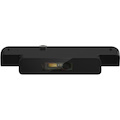Improve application efficiency and network performance with innovative and versatile capabilities that optimize server workloads such as Network Functions Virtualizations (NFV), storage, HPC-AI and hybrid cloud.
The OCP NIC 3.0 specification defines a standardized design for a new generation of network adapters. Simple and straightforward form factors, clear manageability requirements, and improved serviceability help simplify deployment for current and emerging capabilities.
Performance for Cloud Applications
Delivers the bandwidth and increased application throughput required for demanding cloud workloads including edge services, web servers, database applications, caching servers, and storage targets.
- Application Device Queues (ADQ) improves application response time predictability using advanced traffic-steering technology
- Dynamic Device Personalization (DDP) enhances packet classification capabilities, to deliver up to 3x throughput improvement for some cloud workloads
- Supports both RDMA iWARP and RoCEv2 for high-speed, low-latency connectivity to storage targets
Optimizations for Communications Workloads
Provides packet classification and sorting optimizations for high-bandwidth network and communications workloads, including mobile core, 5G RAN, and network appliances.
- Dynamic Device Personalization (DDP) supports existing and new communications-specific protocols improving packet-processing efficiency up to 3x for some NFV workloads
- IEEE 1588 Precision Time Protocol (PTP) v2 support enables precise clock synchronization across the 5G RAN deployments
- Enhanced Data Plane Development Kit (DPDK) support increases packet-processing speeds
Versatile Port Configurations with EPCT
E810-CQDA1 and -CQDA2 adapters for OCP 3.0 support a wide range of system configurations to meet customer needs and workload requirements. The many port and speed combinations available simplify validation and deployment.
All 800 Series products include these technologies | Greater Predictability at Scale
As modern data centers scale, a key challenge is to provide scalable, predictable application-level performance. Application Device Queues (ADQ) technology improves performance scalability and predictability by dedicating queues to key workloads, delivering predictable high performance through dramatically reduced jitter.
Increasing the predictability of application response times by lowering jitter enables more compute servers to be assigned to a task and can allow more users to access the system, providing a better end-user experience. Even applications that are not large scale can benefit from higher consistency, enabling them to meet service-level agreements (SLAs) more easily.
ADQ enables application-specific data steering, signaling, and rate limiting using an optimized application thread to device data path. This ability to dedicate queues and shape network traffic not only increases performance, it reduces latency and improves throughput.
- General Information
- Manufacturer
- Intel Corporation
- Manufacturer Website Address
- http://www.intel.com
- Brand Name
- Intel
- Product Series
- 800
- Product Type
- 100Gigabit Ethernet Card
- Technical Information
- Chipset Manufacturer
- Intel
- Chipset Model
- E810-CAM2
- Interfaces/Ports
- Host Interface
- PCI Express 4.0 x16
- Total Number of Ports
- 2
- I/O Expansions
- Expansion Slot Type
- QSFP28
- Media & Performance
- Media Type Supported
- Optical Fiber
- Maximum Data Transfer Rate
- 100 Gbit/s
- Network & Communication
- Network Technology
- 100GBase-CR2
- 100GBase-CR4
- Physical Characteristics
- Form Factor
- Plug-in Card
- Bracket Height
- OCP
- Miscellaneous
- Application/Usage
- Network
- Device Supported
- Server
- Environmentally Friendly
- Yes
- Environmental Compliance
- Restriction of Hazardous Substances (RoHS)



